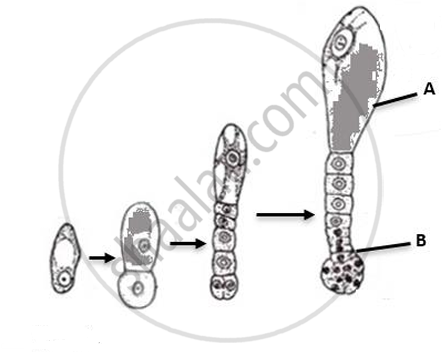Advertisements
Advertisements
प्रश्न
During embryogenesis in dicots, the zygote divides into a basal cell and a terminal cell. The basal cell divides repeatedly to produce a structure called suspensor. Carefully observe the image given below and describe the function of cell – A and cell – B of the suspensor.

Zygote
उत्तर
Cell – A: The haustorial cell absorbs and transfer nutrients from the endosperm to the proembryo.
Cell – B: Hypophysis forms radicle.
APPEARS IN
संबंधित प्रश्न
When and where do chorionic villi appear in humans?
Explain Rh factor incompatibility during pregnancy.
Which of the following hormones is not secreted by human placenta?
The first movements of the foetus and appearance of hair on its head are usually observed during which month of pregnancy?
In the development of the human body, the ectoderm is responsible for the formation of ______.
Read the following and answer from given below:
Cleavage is the series of rapid mitotic divisions in the zygote and forms blastula. The 2, 4, 8, 16 daughter cells are called blastomeres. An embryo with 64 blastomeres is known as a blastocyst and has a blastocoel cavity. Blastocyst gets implanted in the uterine wall and leads to pregnancy.
At which stage of embryonic development does trophectoderm develop?
Explain the formation of placenta after the implantation in a human female.
Draw a diagram showing human foetus within the uterus and label any four, parts in it.
Match the columns I and II with reference to weeks of pregnancy and the development of a human embryo. Select the correct option from the choices given below:
| Column I | Column II | ||
| I. | 8 weeks | (P) | Limbs and external genital organs |
| II. | 12 weeks | (Q) | Limbs and digits develop. |
| III. | 20 weeks | (R) | Body hair develops. |
| IV. | 24 weeks | (S) | Eyelids separate. |
The diagram given below represents a specific stage of human embryonic development. Identify the stage.

